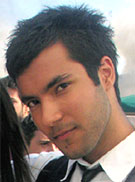 How wonderful! You have just added the
last courses of your undergraduate education. You've got your yearbook picture glorified
with "Photo Shop." You've started to look down on your fashionable jeans because
you are almost ready to fit into a drop-dead-gorgeous suit for the professional career
waiting ahead of you. But wait... are you ready to have your brain stirred up with
interview questions from hell? How wonderful! You have just added the
last courses of your undergraduate education. You've got your yearbook picture glorified
with "Photo Shop." You've started to look down on your fashionable jeans because
you are almost ready to fit into a drop-dead-gorgeous suit for the professional career
waiting ahead of you. But wait... are you ready to have your brain stirred up with
interview questions from hell?
My friend Aslı, who studies at the University of Pennysylvania, started to complain about
the brainteaser interview questions posed to her during a job interview at a large firm in
the US. I couldn't help but wonder what purpose the "interesting" questions they
were asking her served? They surely weren't the type of questions either of us were used
to: "Where do you see yourself in five years?", "What is your biggest
accomplishment?", "Why do you want to work with us?", "Is our question
so cliche that you had already known you would be asked this therefore have studied enough
on it?" THESE are the questions we know!
She was asked: "How many passengers can you fit into a Boeing 737?" Boeing 737?
Passengers? Oh well. I know perfectly well what these sorts of mind benders are called in
the world of physics: "Fermi Problems." They are estimation problems designed
for the teaching of dimensional analysis, approximation and identification of assumptions.
They were named after the 20th Century Professor, Enrico Fermi, who asked his students
these kinds of mind-benders while providing limited data.
Another friend, who studies at Harvard, was asked this question during a job interview:
"You are shrunk to the height of a nickel and your mass is proportionally reduced so
as to maintain your original density. You are then thrown into an empty glass blender. The
blades will start moving in 60 seconds. What do you do?"
"What do you do?" Well, certainly, I would either cry my eyes out - if I still
had them- or wait to die. Joking! It's actually not that hard to answer these questions if
you can use your analytical thinking to make an estimation.
From Wikipedia: "The classic Fermi
problem, generally attributed to Fermi, is "How many piano tuners are there in
Chicago?" For example, we might make the following assumptions:
1. There are approximately 5,000,000 people living in Chicago.
2. On average, there are two persons in each household in Chicago.
3. Roughly one household in twenty has a piano that is tuned regularly.
4. Pianos that are tuned regularly are tuned on average about once per
year.
5. It takes a piano tuner about two hours to tune a piano, including
travel time.
6. Each piano tuner works eight hours in a day, five days in a week, and
50 weeks in a year.
From these assumptions we can compute that the number of piano tunings in a single year in
Chicago is (5,000,000 persons in Chicago) / (2 persons/ household) x (1 piano/20
households) x (1 piano tuning per piano, per year) = 125,000 piano tunings per year in
Chicago. And we can similarly calculate that the average piano tuner performs (50
weeks/year) x (5 days/week) x (8 hours/ day) x (1 piano tuning per 2 hours, per piano
tuner) = 1000 piano tunings per year per piano tuner. Dividing gives (125,000 piano tuning
per year in Chicago) / (1000 piano tunings per, year per piano tuner) = 125 piano tuners
in Chicago."
Well, as you can see, it is most certainly not about the drop-dead-gorgeous suit you have
on your body; it's more about the brain you have inside of your head. Use it.
Yiğit Turhan (EE/IV)
yt_coolhunter@yahoo.com
 |







